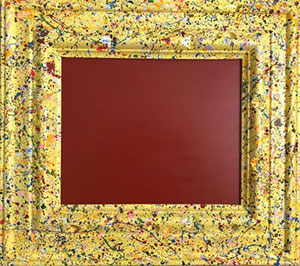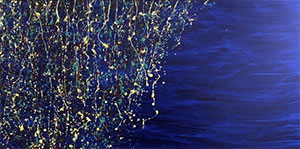
tHE JOURNEY FROM Cubism to Abstraction


Recycled Frame In Yellow, Oil on Board
16 x 18 by artist Dan Taylor
Cubists moved on from the familiar household items — such as flowers, fruits and pots — that had been typical of traditional still-life painting. Unlike their predecessors, they spent more time in cosmopolitan spaces and took a greater interest in objects found in urban settings, such as desks, wine bottles, newspapers and coffee cups. They felt and responded to the energy of city life.
Braque and Picasso experimented with adding newspaper, wallpaper, ornamental patterns, playing cards, and found objects to their work. This practice evolved into Synthetic Cubism, which synthesized various materials, and the technique of collage, whereby many materials were glued to a flat surface to create a composition. In addition to found objects, Cubists added a new dimension to their artwork by incorporating words, letters, and numbers. Undermining distinctions between art forms, Cubism had a significant impact not only on modern painting but also modern sculpture and architecture as well.
Cubism’s Early Influence
During its second phase, Cubism moved away from the strictly somber colors that they had maintained while focusing on form and structure. Though Robert Delaunay began as an impressionist painter who dabbled in Fauvism, he painted the Eiffel Tower at least 30 times during 1910. This focus on urban architecture was essentially Cubist. He and his wife Sonia would found Orphism, which innovatively combined brilliant colors with cubist principles.
The postwar paintings of Fernand Leger, who faced the full horror of World War I as a stretcher carrier, mostly dealt with the evolution of technology and industrialization using Cubist-inspired interlocking geometric shapes. Similarly, the short-lived Italian movement Futurism, active between 1909 to 1916, used the Cubist technique of fragmentation. Futurism suggested movement by breaking down an object into multiple forms and overlapping their disjointed pieces. While Futurists drew from Cubism in their development, their work was more expressive of the dynamic energy of the city and modern technology, while Cubists had primarily sought to represent the true structure underlying their subjects.

Sea Life, oil on canvas12x24 by artist Dan Taylor
Abstraction
Cubists made a decisive break from realism. Once people accepted Cubism, artists felt freer to pursue art that was not strictly representational. In particular, Cubists’ views blazed the trail for the development of abstract art. Kandinsky, the first painter to develop a nonrepresentational style, became increasingly abstract over the course of his career. Though Kandinsky started working much earlier, abstract art became popular in New York in the 1940’s following World War II. Some of the most notable artists of this period, such as Jackson Pollock and Mark Rothko, experimented with splatter paint or other unusual methods to produce abstractions.
Then came the minimalism of the 1960s, when artists longed for simplicity and favored a reserved look over dramatization. The material paint itself was emphasized, rather than the object or subject. Inspired by minimalism, artist Dan Taylor eventually combined a minimalist style with splatter paint to create an art of vibrant color and texture called chromatic minimalism.
Brinda Pamulapati, owner/managing director, of Venvi Art Gallery in Tallahassee, can be reached at (850) 322-0965 or visit www.VenviArtGallery.com